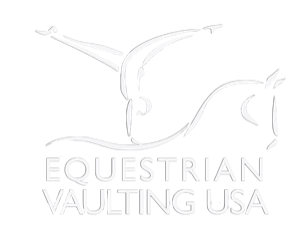Our Parents



“Vaulting gave me the opportunity to be involved with my children and grandchildren, watching them grow in confidence, achieve physically, cry and recover, develop friendships with their teammates, and develop compassion for others.”
- Wayne Beisecker (vaulting father and grandfather, lunger, competition volunteer)
What Parents Should Know
Welcome to EVUSA! Parents are the backbone of our sport; they are on the sidelines cheering and volunteering at local competitions. They are in the background juggling schedules, taking photos, packing lunches, and arranging transportation. For your young athletes, vaulting is a great way to perfect balance, posture, form and strength while on a horse, and is a prerequisite for most riding disciplines in Europe. And equestrians aren’t the only ones who excel in vaulting: gymnasts, dancers and ice skaters also excel in vaulting due to the artistry, movement, musicality, and choreography required. Vaulting is a sport that offers something for people of all ages, abilities and backgrounds.
Vaulting Safety
The Three Points of Vaulting Safety is the basis for EVUSA’s superb safety record and differentiates vaulting from other equestrian sports. The three points consist of the controlled environment in which vaulting takes place; the safety training vaulters complete on the barrel and the horse; and the harmonious nature of the sport and the horse. We also hear a lot of parents ask: But where are their helmets? Vaulters do not wear helmets because of these three points of safety, and also because helmets actually endanger vaulters because they can throw them off balance and get entangled in the horse’s equipment while performing movements. Vaulters perform in a controlled environment on soft sand, on a horse that is controlled by a lunger, and they are taught to dismount (and fall) away from the horse. Click here to learn more about why we don’t use helmets.
How to Get Started
So you’re brand new – and probably feeling a little overwhelmed just like when your child begins any new sport. The vaulting community is helpful and welcoming; simply take these first steps to get your vaulter started:
Get access to the member’s section of the website and notifications about upcoming competitions and events. Click here to learn more.
There are hundreds of clubs in the US. Here’s a map to find one close to you.
Talk to your coach about what your vaulter will need. Vaulters usually start with form-fitting exercise clothes and vaulting shoes.
Ask your club if they have events where you can meet other parents or even social media groups you can join.
Whether you’re a beginning or advanced vaulter, parent, lunger, or coach, there’s is an educational track for you at the annual symposium, typically held in the spring.
Your club likely needs volunteers and will appreciate any assistance you can offer. It takes a village to raise great vaulters!
Training to Vault
Many beginning vaulters meet once per week with their club. They stretch and complete warm-up activities, practice their moves on a barrel, move onto the horse, and then participate in cool-down stretches. More advanced vaulters train multiple times per week. Yoga and stretch classes are often included in their vaulting training and are greatly encouraged. At most clubs, vaulters can choose a recreational path or a competitive path. Recreational vaulters practice their skills to get stronger, grow their confidence with horses, and have fun with their friends. Competitive vaulters are interested in performing in front of judges to get feedback on what they’ve learned. Once a vaulter is ready to compete, he can start on a barrel first or go right into horse vaulting classes. As vaulters advance, they move to trot and then canter. They can compete individually, in pairs and with a team.
“My favorite thing to watch (hands down!) is my daughter start to give back to the community by mentoring younger vaulters and judging at regional events.”
- Beth Whillock, Northern Lakes Vaulters
